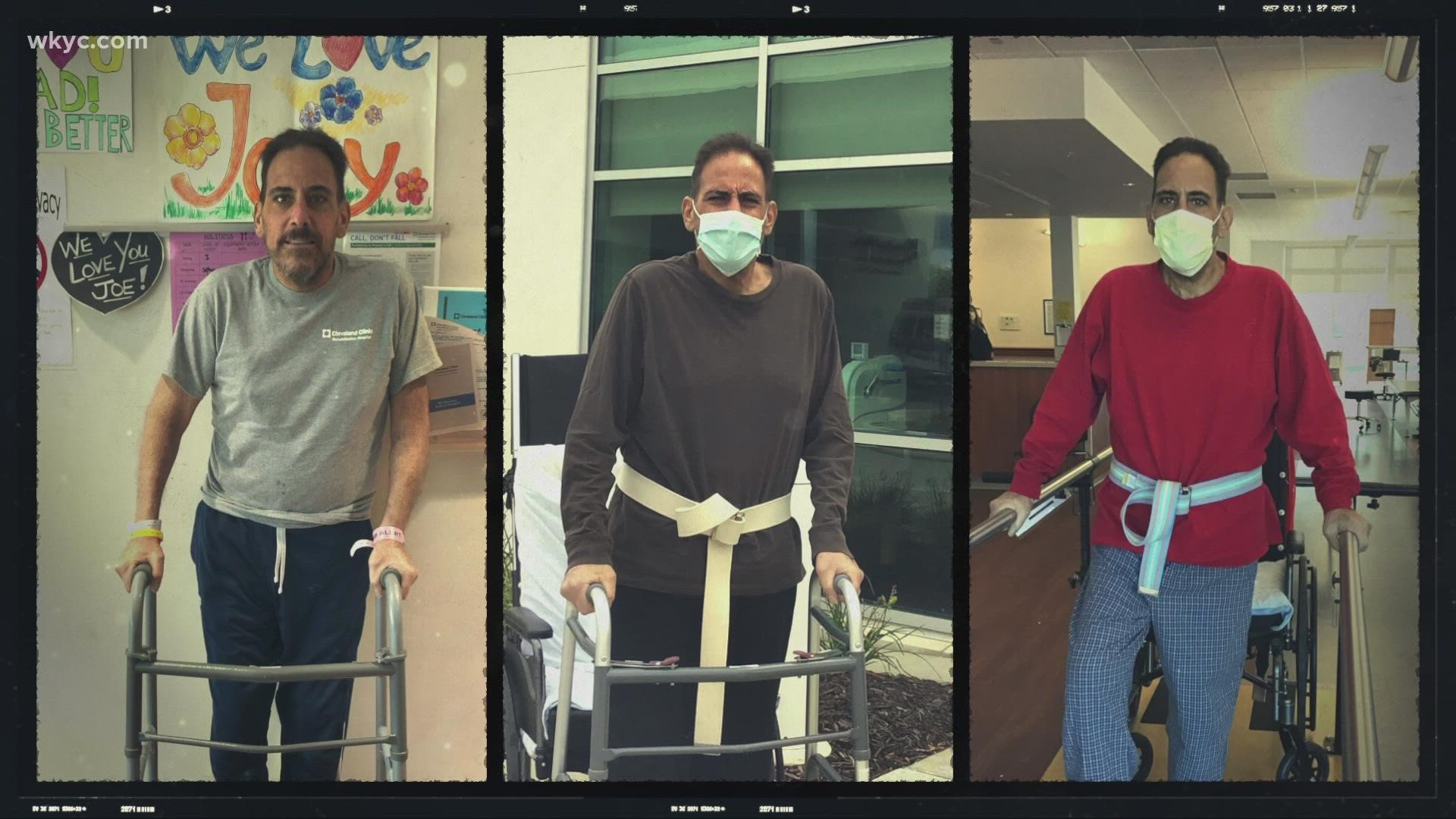CHAGRIN FALLS, Ohio — For the last two years, COVID-19 dominated the news and our lives. While we're getting a respite with declining cases, the pandemic is not over, and for some, it won't be over for years.
The physical damage left behind may take years to discover and find adequate treatments. Patients are in it for the "Long Haul," and we're traveling it with them, bringing you the stories, the discoveries, and the impact the pandemic left behind.
595 days.
That's how long it took Joe Nero, of Chagrin Falls, to get back to work after being hospitalized with the devastation COVID-19 did to his body.
It all began on April 27, 2020, the very beginning of the pandemic. Joe and his wife, Laura, took the pandemic seriously. They were paying attention to information, and early on they were wiping down their grocery bags. Like the rest of Ohio, they were in lockdown.
Joe has no idea how he became infected with the virus. That April day, he was suffering from severe abdominal pain and numbness in his legs. That certainly didn't sound like COVID, and technically it wasn't, at that time.
In reality, he was suffering from the damage COVID did to his body, specifically blood clots.
"I don't even remember getting dropped off, and the next thing you know, I wake up in August," Joe told us.
Joe Nero's coronavirus odyssey brought the 58-year-old to death's door, more than a few times. But each time, he fought back.
"When I went in there, I was a solid 220 pounds. I could move a mountain," he remembered. "[Months later], I was 154 pounds. I couldn't move the tray; I thought it was glued to the floor. I thought everything was. I had no strength, I couldn't walk, I couldn't lift my arms. I talked to my brother outside the window and I can't even hold the phone up, and I’d just nod off."
The journey started at Hillcrest Hospital before Nero was transferred to Cleveland Clinic's main campus and then to various rehab centers. Six different Cleveland Clinic Hospital centers in six months.
The first hospital stay lasted 170 days. He was placed on and off a ventilator, as needed. Multiple blood clots required three feet of intestine to be removed. His gallbladder became gangrenous and had to be partially removed. He developed pneumonia, had a lung collapse, and suffered acute liver failure. He also suffered acute kidney failure and needed months on dialysis.
Procedure after procedure weakened Joe's already fragile system. Then, he developed sepsis. Each of these issues was potentially fatal, and near the end of it all in the fall of 2021, all the procedures gave him a hernia.
Nero went in for yet another operation, but ended up staying another 10 days in the hospital because the blood thinners he'd been taking for the blood clots caused internal bleeding at the hernia site.
Total days in the hospital: 190. That didn't include spending nearly four days a week in and out of doctor offices and rehab centers during 2021.
Dr. Michael Pollack, a Cleveland Clinic gastroenterologist, was the last of a long list of doctors involved in Joe's care. When Pollack read Joe's chart, he was in disbelief.
"I mean, the first thing I thought was, 'Wow, this guy is alive,'" Pollack said. "I'm looking at him like almost like a miracle man. This is a man made out of steel, but not only physically, but also from a mental standpoint."
Another interesting fact of Joe's case is that he never actually tested positive for COVID-19, but all of his doctors insist the virus is what caused his cascading issues.
Pollack explained that in the early days of the pandemic, the testing was still new and not quite as sensitive. He believes Nero developed COVID in early April, but by the time the symptoms were bad enough that he went to the hospital, there was no longer detectable virus in his system. Despite this, the damage had already been done.
At the time, doctors were also just learning that blood clots were another symptom of COVID infections. Joe credits his survival to his wife, his kids, and his faith.
"Cleveland Clinic did a fantastic job, but we all have our limits," he declared. "That was the deciding factor. Without Jesus, this wasn't happening."
Nero returned home with both a walker and a wheelchair; his office became his bedroom on the first floor. After being away so long, his home and his body both felt foreign.
"It was like the hospital was my home," he explained, "and this was the place I was visiting."
Joe Nero is the face of a COVID Long Hauler. The myriad of lingering symptoms is extensive, including fatigue, brain fog, memory loss, headaches, blood clots, neuropathy or nerve damage, and kidney damage. He's learned there is no end date for how long these symptoms will last or if they'll ever go away, but he does know one thing.
"I get a second chance," he said. "A lot of people had this and many of them are gone — friends, relatives we had, gone. All gone. It was hard."
This Long Hauler has a message for others: Don't minimize the human cost of COVID, not just now, but down the road, too.
"To see the amount of families lost by this and the amount of people that are going to be affected by this years to come, it's scary," he lamented. "I'm just going to live life as best as I can and try to get back to normal as much as possible."

